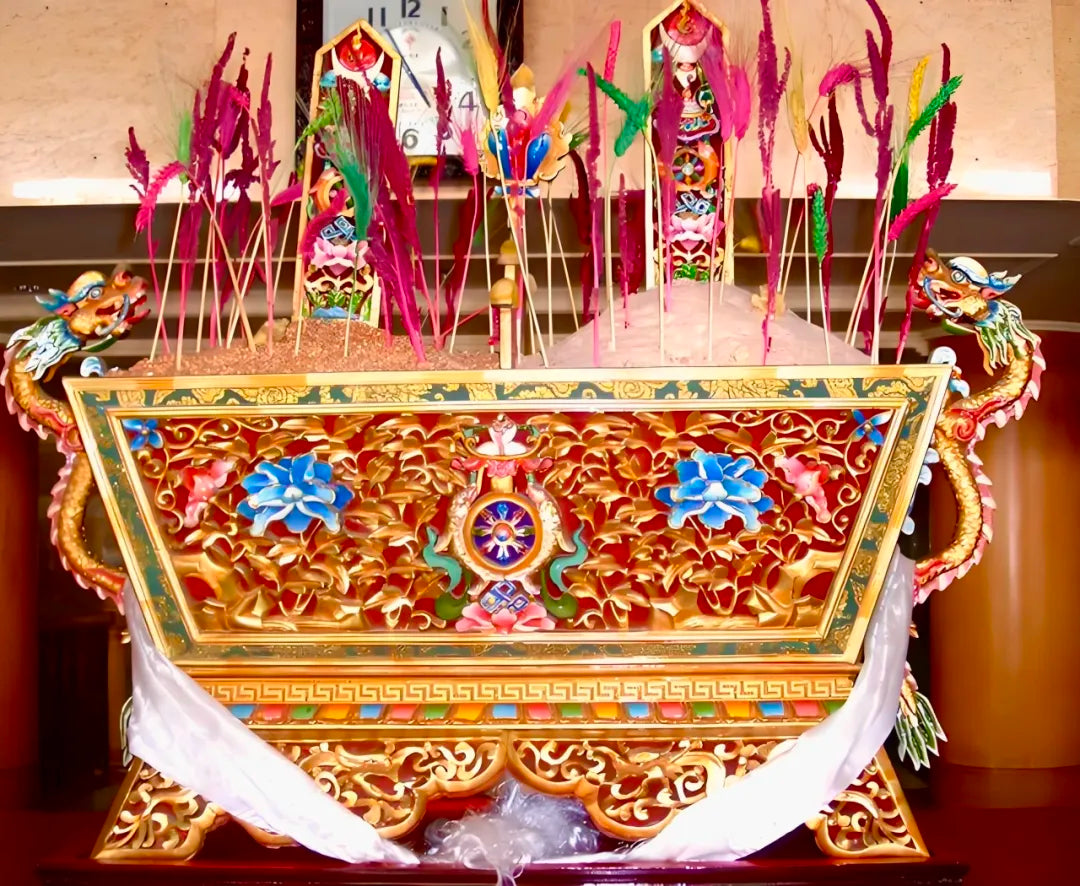
Tibetan "Qemar Box" ▎ A treasure box carrying good luck and blessings.

Tibetan Box
There are a variety of boxes in traditional Tibetan culture. For example, one of the most well-known is the Gau box, which is a talisman containing scriptures that people carry with them daily. While serving as a prayer tool, it also becomes a decorative item, with the same function as accessories. In temples, there are scripture boxes that store important scriptures and scrolls, while Tibetan medicine practitioners have medicine boxes for traditional Tibetan medicine and herbs. In the past, noble families had treasure boxes for storing precious items such as natural jewelry.
These boxes are designed differently based on their purposes, but they share the common feature of being exquisitely designed. They may be intricately carved, intricately painted, intricately inlaid, or creatively combined. Through extraordinary creativity and skilled craftsmanship, they transcend their practical utility and become highly valued works of art, providing aesthetic enjoyment and serving as a spiritual space where people can find solace through the fusion of religious and cultural elements.

Qemar Box
The Qemar box(ཕྱེ་མར་འབོ།), from a practical perspective, is simply a special box for storing barley, but from a cultural perspective, it is a box that carries wishes and blessings, symbolizing offerings and devotion. By translating "切玛盒" into English, we can observe and appreciate its significance from a different cultural perspective, which may help us better understand its usage and peek into its profound cultural background.

This reflects a sense of etiquette and morality, allowing people to comprehend and deeply feel the connection and circulation of positive energy. It also embodies the simple and pure belief concept of the Tibetan people.

Over time, ordinary boxes filled with grains gradually acquired various unique meanings, such as expectations for a bountiful harvest and celebrations of happiness and auspiciousness. The Qemar box thus transcended its utilitarian function as a common tool and became a sacred gift with abstract meaning, serving as a vessel for carrying people's spiritual beliefs.

Carved Qemar box, beauty in ordinary homes.
The shape of a Tibetan butter tea box is generally shaped like a scoop, with the internal space divided into two compartments. One compartment contains roasted barley grains, while the other compartment contains tsampa mixed with butter. Both compartments are usually filled to form a golden character, symbolizing abundance and prosperity. The box is then decorated with colorful grain ears and delicate butter flower patterns, creating a Tibetan butter tea box.
Tibetan Qemar boxes are typically made from soft and flexible poplar wood for practical and economic reasons. The soft wood also allows for further carving and decoration, enhancing the aesthetic appeal of the box. Higher quality boxes are often made from finer and tougher cedar wood, suitable for preserving as a family heirloom for generations.
 Chamagudao box beautifully decorated, symbolizing a bountiful harvest
Chamagudao box beautifully decorated, symbolizing a bountiful harvest
The making of Tibetan incense boxes not only reflects the exquisite craftsmanship and extraordinary creativity and wisdom of the artisans, but also materializes people's aspirations and yearning for a better life.

Offering up a qemar box,
may wishes come true.
The rich and ancient culture of Tibet makes it easy for us to discover the shadow of Qemar Box in the many folk stories and legends that have been passed down to this day. These stories may express beliefs or love, and different expressions correspond to different versions of the story.



Through these stories, we can better understand the significance of the Qemar box in the cultural context of Tibet, and its important role in everyday life. We can see how people cherish and respect the Qemar. The Qemar box not only serves as a practical tool that enhances people's lives, but also reflects their spiritual world, depicting their love for life and pursuit of truth, goodness, and beauty.
Full of good fortune and blessings
In Tibetan tradition, the Qemar box is widely used in both secular life and religious ceremonies. In secular life, the Qemar box often appears in various festive occasions, such as New Year and weddings, as an essential auspicious symbol for celebrations and welcoming guests. In religious ceremonies, the Qemar box is mainly used as an important offering, placed on the altar to express reverence and seek protection and blessings.

Scholar Jiacuo Dunzhu describes the custom of taking a bride in Tibet in his introduction to the charm of the snowy region, mentioning the ritual of offering the "quemar" (quima, in the original text). From this, we can vividly feel the importance of the quemar box in Tibetan life.
The specific invocation goes as follows: "The quemar is piled up like a snowy mountain, with butter and colorful flowers like the sun and moon. Five-colored grains like the golden autumn, symbolizing a bountiful harvest. Wheat on top of the quemar box, symbolizing everything going smoothly. Salt on top of the quemar box, symbolizing power and wealth. Vegetable seeds on top, symbolizing the prosperity of future generations. With eight thousand fruits on the box, symbolizing eternal prosperity. Praying to the heavenly gods for blessings, the earth gods for peace, and the dragon king for wealth. Taking a pinch of the offering for good luck."

As the saying goes in Chinese culture, even though a sparrow is small, it has all the vital organs. Similarly, the Qemar box contains a world of its own. A simple designed square wooden box filled with a variety of richly decorated items, each carrying their own auspicious symbolism and playing different roles to express different blessings. It gathers sincere wishes, making it in a way an unquestionable treasure trove.

Image: National Geographic China
On special occasions, people sincerely offer Qemar Box as a token of blessing and respect to their guests, showing kindness to others and celebrating the joy of harvest, expressing gratitude for the gifts of nature.


